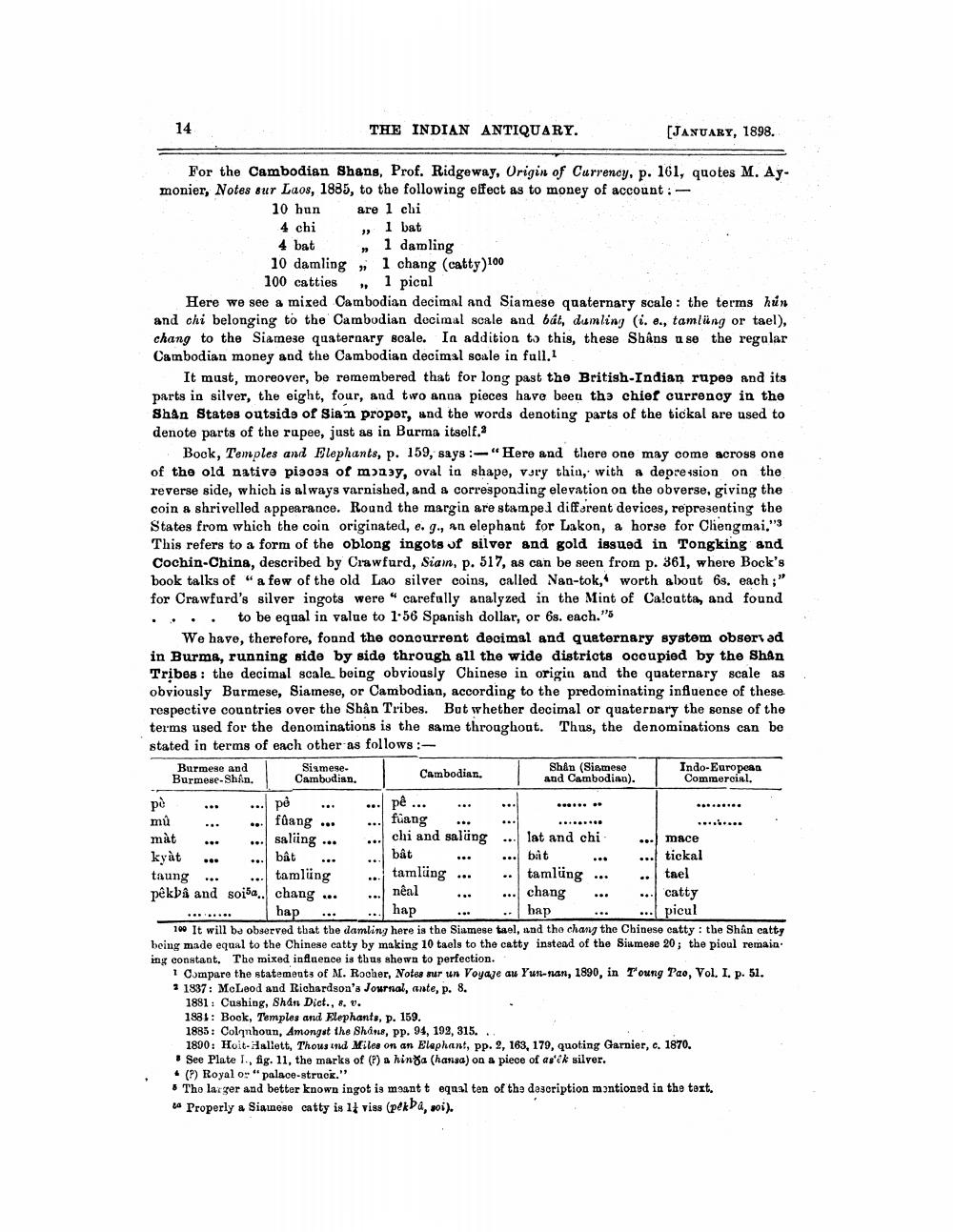________________
14
THE INDIAN ANTIQUARY.
[JANUARY, 1898.
For the Cambodian Shang, Prof. Ridgeway, Origin of Currency, p. 161, quotes M. Ay. monier, Notes sur Laos, 1885, to the following effect as to money of account:
10 hun are 1 chi 4 chi
1 bat 4 bat
1 damling - 10 damling, 1 chang (catty)100
100 catties 1 pical Here we see a mixed Cambodian decimal and Siamese quaternary scale : the terms hún and chi belonging to the Cambodian decimal scale and bát, dumling (i. e., tamlüng or tael), chang to the Siamese quaternary scale. In addition to this, these Shâns ase the regalar Cambodian money and the Cambodian decimal soale in full.
It must, moreover, be remembered that for long past the British Indian rupee and its parts in silver, the eight, four, and two anna pieces have been thu chief currency in the Shan States outside of Sian proper, and the words denoting parts of the tickal are used to denote parts of the rapee, just as in Burma itself.3
Bock, Temples and Elephants, p. 159, says : -"Here and there one may come across one of the old nativa piscas of masy, oval in shape, vury thin, with a depression on the reverse side, which is always varnished, and a corresponding elevation on the obverse, giving the coin a shrivelled appearance. Round the margin are stampe i different devices, representing the States from which the coin originated, e. ., an elephant for Lakon, a horse for Chengmai." This refers to a form of the oblong ingots of silver and gold issued in Tongking and Cochin-China, described by Crawfurd, Siam, p. 517, as can be seen from p. 361, where Bock's book talks of "a few of the old Lao silver coins, called Nan-tok, worth about 6s. each ;" for Crawfurd's silver ingots were carefully analyzed in the Mint of Calcutta, and found . .. to be equal in value to 1.56 Spanish dollar, or 6s. each."
We have, therefore, found the concurrent decimal and quaternary system observad in Burma, running side by side through all the wide districts occupied by the Shan Tribes: the decimal scale being obviously Chinese in origin and the quaternary scale as obviously Burmese, Siamese, or Cambodian, according to the predominating influence of these respective countries over the Shân Tribes. But whether decimal or quaternary the sonse of the terms used for the denominations is the same throughoat. Thus, the denominations can be stated in terms of each other as follows: Burmese and Siamese.
Shin (Siamese
Indo-European Burmese-Shiin. Cambodian.
Cambodian. aud Cambodian).
Commercial pè mú
fgang ...
füang mặt . saliing ...
chi and saläng ... lat and chi +
... mace kyat ... bânt ...
bât bit
tickal taung .. tamling
tamläng ... tamlüng ... .. tael pêkbi and soi5a.. chang ...
chang
catty ........ hap ... hap ... ..hap
picul 100 It will be observed that the damling here is the Siamese tael, and the chang the Chinese catty : the Shân catty being made equal to the Chinese catty by making 10 taels to the catty instead of the Siamese 20; the pioul remain ing constant. The mixed influence is thus shewn to perfection.
1 Compare the statements of N. Rocher, Notes sur un voyage au Y 41-9an, 1890, in T'oung Tao, Vol. I. p. 51. ? 1837: McLeod and Richardson's Journal, ante, p. 8.
1881: Cushing, Shan Dict., 8. v. 1831: Bock, Temples and Elephants, p. 159. 1885: Colqnhoun, Amongst the Shans, pp. 94, 192, 315....
1890: Hoit-Hallett, Thousand Miles on an Elephant, pp. 2, 163, 179, quoting Garnier, c. 1870. " See Plate 1. fig. 11, the marks of (?) a hinga (hansa) on a piece of as'ck silver. * (?) Royal o "palace-struck." • The larger and better known ingot is meant t equal ten of the description montioned in the text. La Properly a Siainese catty is 11 viss (pekba, si).
pe
pe ...
nêal




